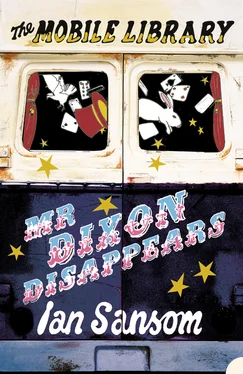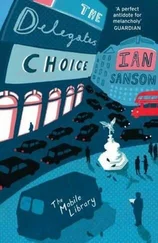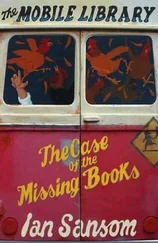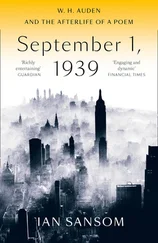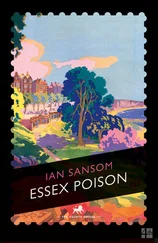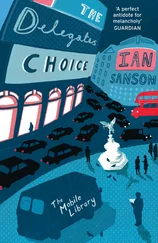The building itself was three storeys high, wide and spreading, and painted a lurid carnation pink, with palm trees planted all round it: it reminded Israel of a giant plate of salmon blini with chives, and it certainly looked as though it belonged somewhere else, in Miami maybe, or on a fully loaded side table at a north London bar mitzvah party, and definitely not on the lonely north coast of Ireland.
There was absolutely no doubt about it: Dixon and Pickering’s was unique. Dixon and Pickering’s was undoubtedly – as one of the titles on the helpful A3-size laminated sheets of Israel’s five-panel touring exhibition pointed out – A Landmark and A Legend.
Israel parked up.
It was raining, of course. It was always raining in Tumdrum. Even if it wasn’t raining, not at that actual moment, then it was getting ready to rain, biding its time, waiting until you’d left the house without your coat and umbrella and you were more than halfway to wherever it was you were going so it was too late to turn back, and then whoosh!, suddenly you were wet right through.
It rained here all the time, but still it somehow caught you unawares, creeping up on you. If it was possible for weather to be duplicitous and undermining, then Tumdrum’s weather was: it was bad weather, morally bad weather; it was rain that left no visible trace, no puddles, only a deep-down damp, a remorseless damp that at first you couldn’t get out of your clothes and then you couldn’t scrub out of your skin and then you couldn’t dig out of your soul; the kind of damp that if you could have smoked it, you wouldn’t have known but already you’d be addicted.
And what was worse even than the soul-destroying rain was that around Tumdrum the sky always seemed to be the colour of the road and the road was always the colour of the sky, a grey, grey, grey, one of a million shades of grey that Israel knew by heart by now, and today, this morning, it still being early, the sky was a kind of beige grey, like the trim in the interior of a particularly nasty 1970s sports car, the shade of a soulless future.
The caretaker emerged from the back of the store and into the rain and waved Israel over.
‘Come on ahead then. I’ll show you where you’re setting up.’
‘Would you mind, just…’ Israel turned up the hood on his duffle coat and half-heartedly indicated back towards the van, to the bags of poles and panels for the display, but the caretaker had gone already. So Israel followed him up the stone steps and inside the famous big pink building.
The back entrance took you in through kitchenware and hardware, Panasonic bread-makers to the left of you, pop-up gazebos and battery display stands to the right. A worn but clean red carpet led through the store, up past linen and beds, skirting contemporary furniture and on through greetings cards, stationery, board games and leather goods until finally you reached the front entrance to the store, where, as is traditional, you could purchase gifts, watches, jewellery and crystal at the foot of a wide staircase which took you up to ladies’ fashions and accessories.
‘Here’s you,’ said the caretaker, indicating a tiny space between the sweeping staircase and a jumble of glass display cases featuring vases, decanters and earrings.
‘I don’t know if I’ll be able to squeeze everything…’
But the caretaker had gone.
Right, thanks.
Israel trudged back through the store – he was trudging because his old brown brogues were slowly breaking down, widening and splitting, the leather uppers and the smooth leather soles unable to contend with the fast pace, the pounding, and the never-ending dung of country living – and he prepared to unload the exhibition through the disabled access door at the back of the mobile library. Which was easier said than done.
The disabled access door was actually more likely to render you disabled than to ease your access: it was pretty stiff to open, where someone had rear-ended the van at some time, and when you did get it open you had to tie it back with a piece of string because the catch had gone, and the roll-a-ramp itself weighed a ton and was a bugger to fold up and down.
But then the whole van was just like that, and you got used to her eventually, and as long as you watched the oil, and the tyre pressure and the water, and kept her doors lubricated with petroleum jelly, and remembered not to use the full trigger on the petrol pump when you were filling her up, and had a couple of spare alternator belts on board at all times, and as long as you had a dedicated full-time mechanic on hand, then really she was no trouble at all. She took a little more care and maintenance than Israel’s mum’s old Honda Civic back home in London, but then you couldn’t get two thousand books and fully adjustable shelving in a Honda Civic – in fact, as far as Israel remembered, you’d be lucky to be able to get the weekly supermarket shop, a bag of sucky chocolate limes and a handful of CDs in a Honda Civic. To his surprise, Israel seemed to have outgrown little city runabouts. He’d grown accustomed to the van and to her big old-fashioned country ways; he’d got used to grinding the gears, and the uncomfortable, elevated driving position, and he’d grown accustomed to listening out for the little rattles and shakes that meant he needed to get Ted to take a look at the engine before the whole thing blew. As long as Israel didn’t have to touch anything mechanical, as long as everything was going smoothly, he was absolutely fine.
He checked his watch. Ted was supposed to be meeting him, but there was no sign of him. He was going to have to do it all by himself.
He eventually dragged all the display poles and panels out of the van and through the store and started setting up.
The caretaker had turned some music on, which was now flooding the huge empty spaces of the store, filling up every little crack, like grains of sand in a picnic or long white worms of Polyfilla from a tube. There was ‘Dancing Queen’ by ABBA, and Chris De Burgh’s ‘Lady in Red’, and Elton John’s ‘Candle in the Wind’, all played just below tempo, legato, and with humming low chords, each song bleeding into the other, with a generous use of alto sax and what sounded like a flugelhorn, or a muted flugelhorn, or maybe a nose-flute to carry the melody, a sound so mucousy and clotted it made you feel all bunged-up and fluey just hearing it. TV theme-tunes from the 1970s merged seamlessly with pop hits of the 1980s and the Beatles, the slow songs played too fast, and the fast songs played too slow. He had a headache before: now he was actually beginning to feel sick. His hands were sweaty.
When Linda Wei had shown him in her office how to set up the panel display – or the ‘Velcro-Compatible Exhibition and Display System’, as she insisted on calling it – she’d had it done in minutes, with a cherry scone in hand, and it had looked perfectly simple, but, like most things in life, it turned out only to be simple once you knew how to do it. It took Israel two hands and goodness knows how long of pressing and clicking poles and lifting panels into position to the accompaniment of Boney M, Stevie Wonder, Kris Kristofferson, Celine Dion and the theme from Miami Vice , but when he finally got it up it was pretty solid, and if he said so himself his full-colour five-panel display on the history of Dixon and Pickering’s looked pretty good. He couldn’t deny it, he was proud of his work: on this day, at this moment in time, to his own surprise and doubtless to the amazement of others, if they’d been in the slightest bit interested, Israel Armstrong probably knew more about the history of Dixon and Pickering’s than anyone else alive.
He knew all about how the original Mr Dixon, the haberdasher, the man with the vision, had inherited money from a distant relative sent out to seek his fortune in New South Wales, and how he had joined forces with the original Mr Pickering, the milliner, the man with the eye for detail, and how the two of them had dreamt of a department store to rival those of London and Dublin, selling fancy goods and fine china, and wallpaper and animal feed. He knew how they had raised the money for the building from financiers; and how the revolutionary steel-frame building had been constructed partly on site and partly in Glasgow and then shipped over. And he knew all about the original layout of the store, with the little mahogany booths on the ground floor, with William Patterson the Watch Doctor tucked up in one, King’s Barber Shop in another, and Mr E. Taylor the Tailor alongside them; and how the booths were replaced in the 1940s with stained-pine counters, and how eventually the whole store had gone open-plan in the sixties, when the oak-panelled entrance hall was remodelled and the revolving door removed and replaced with something state-of-the-art in shiny metal and plastic; and now all that remained inside of the original building was the old staircase. Israel had read and carefully noted down all this information from the archives of the Impartial Recorder , and from the old Dixon and Pickering business ledgers now kept in Rathkeltair library, and he had rendered it all lovingly in laminated text and photos, and had pinned it up with his own hand with drawing-pins to the Velcro-Compatible Exhibition and Display System.
Читать дальше
